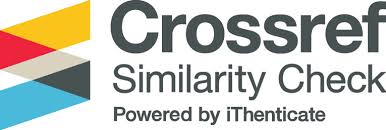Comparison of Antioxidant Activity of Pure Extract, Granule and Effervescent Tablet of Manggosteen rind Extract (Garcinia Mangostana L.)
Abstract
The mangosteen rind (Garcinia mangostana L.) contains alkaloids, flavonoids, triterpenoids, tannins, and polyphenols. Flavonoids are secondary metabolites found in it which act as antioxidants. Research on antioxidant activity testing with samples of pure extract, effervescent granules, and effervescent tablets from mangosteen rind extract was conducted to determine the antioxidant content in each formulation. The extraction method used in the study was maceration with 96% ethanol solvent followed by rotary evaporation and water bath at 40°C to obtain a concentrated extract. The yield of the extract was 23.4%, meeting the criteria for a good extract. The concentrated extract was then dried in an oven at 40°C to obtain dry extract. Subsequently, phytochemical screening of the mangosteen rind extract was performed to identify the secondary metabolites present. Antioxidant activity testing was conducted using the DPPH method with methanol as the solvent and quercetin as the positive control. The strongest IC50 value was found in the pure mangosteen rind extract with a value of 0.037 ppm, followed by the effervescent granules with an IC50 value of 0.607 ppm, and the effervescent tablets with an IC50 value of 2.517 ppm. A smaller IC50 value indicates a higher antioxidant capacity in scavenging free radicals.
References
[2]. Andayani R, Novita R, Verawati. Pengaruh Metode Ekstraksi Terhadap Kadar Xanthone Total Ekstrak Kulit Buah Manggis Matang (Garcinia mangostana L.) dengan metode Spektrofotometri Ultraviolet. Prosiding Seminar Nasional & Workshop. 2015.
[3]. Rizkyanti, Wahid A, Diah M, & Jura RM. Uji Aktivitas Antioksidan Ekstrak Air dan Ekstrak Etanol Daun Kelor (Moringa oleifera Lam). Jurnal Akademika Kimia. 2017. 125-131.
[4]. Hasanah N, Dahlia AA, Handayani V. Uji Aktivitas Ekstrak Daun Kedondong Laut (Nothopanax Fruticosum (L.) Miq) dengan Metode Peredaman Radikal Bebas DPPH. Jurnal Produk Alami Makassar. 2023. 1(2) : 10-17
[5]. Rahmah S. Formulasi Dan Evaluasi Sediaan Lip Balm Dari Ekstrak Kulit Manggis (Garcinia mangostana L.). Sekolah Tinggi Ilmu Kesehatan Medistra Indonesia. 2023.
[6]. Nadia S, Zebua FN, Salsabila D. Uji Aktivitas Antioksidan Ekstrak Etanol Kulit Buah
Manggis (Garcinia mangostana L.) dalam Sediaan Serum Dengan Metode DPPH. Jurnal Farmasi Dan Sains. 2022. 55(2) : 372-380.
[7]. Karima N, Pratiwi L, Apridamayanti P. Identifikasi Senyawa Kuersetin Ekstrak Etil Asetat Daun Senggani (Melastoma malabathricum L.) dengan Metode Kromatografi Lapis Tipis (KLT). 2019. 4(1).
[8]. Puspitasari L, Swastini DA, Arisanti CIA. Skrining Fitokimia Ekstrak Etanol 95 Kulit Buah Manggis (Garcinia Mangostana L.). Jurnal Farmasi Udayana. 2013. 1-4
[9]. Nabillah AD, Stiani NS, Udin B, Lutfiyah F. Analisis Antioksidan Ekstrak Kulit Buah Manggis (Garcinia mangostana L.) Menggunakan Metode DPPH (2,2 -Diphenyl -1 -picrylhydrazyl). Jurnal Ilmiah Kesehatan Delima. 2023. 6(1) : 1-7.
[10]. Kumalasari E, Septia A, Febrianti AR, Aisyah N. Penetapan Kadar Flavonoid Total Ekstrak Etanol dan Fraksi Etanol, Fraksi Kloroform, Fraksi N-Heksana, Fraksi Air, Fraksi Etil Asetat dari Daun Bawang Dayak (Eleutherine palmifolia (L.) Merr.). 2023. 9(2): 167-173.
[11]. Andriana CR, Murod, Chabib L. Formulasi Tablet Hisap Ekstrak Kulit Buah Manggis (Garcinia Mangostana L.) sebagai Antioksidan dengan Variasi Konsentrasi Gelatin sebagai Bahan Pengikat. Khazanah. 2014. 6(2).
[12]. Sulistiani DN, Anam C, Yudhistira B. Karakteristik Tablet Effervescent Labu Siam (Sechium Edule Sw.) dan Ekstrak Secang (Caesalpinia Sappan L.) dengan Filler Laktosa mannitol. Jurnal teknologi hasil pertanian. 2018. 11(2).













